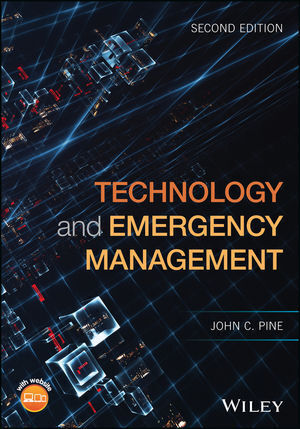Dekorationsartikel gehören nicht zum Leistungsumfang.
Sprache:
Englisch
85,90 €*
Versandkostenfrei per Post / DHL
Aktuell nicht verfügbar
Kategorien:
Beschreibung
The first book devoted to a critically important aspect of disaster planning, management, and mitigation
Technology and Emergency Management, Second Edition describes best practices for technology use in emergency planning, response, recovery, and mitigation. It also describes the key elements that must be in place for technology to enhance the emergency management process. The tools, resources, and strategies discussed have been applied by organizations worldwide tasked with planning for and managing every variety of natural and man-made hazard and disaster. Illustrative case studies based on their experiences appear throughout the book.
This new addition of the critically acclaimed guide has been fully updated and expanded to reflect significant developments occurring in the field over the past decade. It features in-depth coverage of major advances in GIS technologies, including the development of mapping tools and high-resolution remote sensing imaging. Also covered is the increase in computer processing power and mobility and enhanced analytical capabilities for assessing the present conditions of natural systems and extrapolating from them to create accurate models of potential crisis conditions. This second edition also features a new section on cybersecurity and a new chapter on social media and disaster preparedness, response, and recovery has been added.
* Explores the role of technology in emergency planning, response, recovery, and mitigation efforts
* Explores applications of the Internet, telecommunications, and networks to emergency management, as well as geospatial technologies and their applications
* Reviews the elements of hazard models and the relative strengths and weaknesses of modeling programs
* Describes techniques for developing hazard prediction models using direct and remote sensing data
* Includes test questions for each chapter, and a solutions manual and PowerPoint slides are available on a companion website
Technology and Emergency Management, Second Edition is a valuable working resource for practicing emergency managers and an excellent supplementary text for undergraduate and graduate students in emergency management and disaster management programs, urban and regional planning, and related fields.
Technology and Emergency Management, Second Edition describes best practices for technology use in emergency planning, response, recovery, and mitigation. It also describes the key elements that must be in place for technology to enhance the emergency management process. The tools, resources, and strategies discussed have been applied by organizations worldwide tasked with planning for and managing every variety of natural and man-made hazard and disaster. Illustrative case studies based on their experiences appear throughout the book.
This new addition of the critically acclaimed guide has been fully updated and expanded to reflect significant developments occurring in the field over the past decade. It features in-depth coverage of major advances in GIS technologies, including the development of mapping tools and high-resolution remote sensing imaging. Also covered is the increase in computer processing power and mobility and enhanced analytical capabilities for assessing the present conditions of natural systems and extrapolating from them to create accurate models of potential crisis conditions. This second edition also features a new section on cybersecurity and a new chapter on social media and disaster preparedness, response, and recovery has been added.
* Explores the role of technology in emergency planning, response, recovery, and mitigation efforts
* Explores applications of the Internet, telecommunications, and networks to emergency management, as well as geospatial technologies and their applications
* Reviews the elements of hazard models and the relative strengths and weaknesses of modeling programs
* Describes techniques for developing hazard prediction models using direct and remote sensing data
* Includes test questions for each chapter, and a solutions manual and PowerPoint slides are available on a companion website
Technology and Emergency Management, Second Edition is a valuable working resource for practicing emergency managers and an excellent supplementary text for undergraduate and graduate students in emergency management and disaster management programs, urban and regional planning, and related fields.
The first book devoted to a critically important aspect of disaster planning, management, and mitigation
Technology and Emergency Management, Second Edition describes best practices for technology use in emergency planning, response, recovery, and mitigation. It also describes the key elements that must be in place for technology to enhance the emergency management process. The tools, resources, and strategies discussed have been applied by organizations worldwide tasked with planning for and managing every variety of natural and man-made hazard and disaster. Illustrative case studies based on their experiences appear throughout the book.
This new addition of the critically acclaimed guide has been fully updated and expanded to reflect significant developments occurring in the field over the past decade. It features in-depth coverage of major advances in GIS technologies, including the development of mapping tools and high-resolution remote sensing imaging. Also covered is the increase in computer processing power and mobility and enhanced analytical capabilities for assessing the present conditions of natural systems and extrapolating from them to create accurate models of potential crisis conditions. This second edition also features a new section on cybersecurity and a new chapter on social media and disaster preparedness, response, and recovery has been added.
* Explores the role of technology in emergency planning, response, recovery, and mitigation efforts
* Explores applications of the Internet, telecommunications, and networks to emergency management, as well as geospatial technologies and their applications
* Reviews the elements of hazard models and the relative strengths and weaknesses of modeling programs
* Describes techniques for developing hazard prediction models using direct and remote sensing data
* Includes test questions for each chapter, and a solutions manual and PowerPoint slides are available on a companion website
Technology and Emergency Management, Second Edition is a valuable working resource for practicing emergency managers and an excellent supplementary text for undergraduate and graduate students in emergency management and disaster management programs, urban and regional planning, and related fields.
Technology and Emergency Management, Second Edition describes best practices for technology use in emergency planning, response, recovery, and mitigation. It also describes the key elements that must be in place for technology to enhance the emergency management process. The tools, resources, and strategies discussed have been applied by organizations worldwide tasked with planning for and managing every variety of natural and man-made hazard and disaster. Illustrative case studies based on their experiences appear throughout the book.
This new addition of the critically acclaimed guide has been fully updated and expanded to reflect significant developments occurring in the field over the past decade. It features in-depth coverage of major advances in GIS technologies, including the development of mapping tools and high-resolution remote sensing imaging. Also covered is the increase in computer processing power and mobility and enhanced analytical capabilities for assessing the present conditions of natural systems and extrapolating from them to create accurate models of potential crisis conditions. This second edition also features a new section on cybersecurity and a new chapter on social media and disaster preparedness, response, and recovery has been added.
* Explores the role of technology in emergency planning, response, recovery, and mitigation efforts
* Explores applications of the Internet, telecommunications, and networks to emergency management, as well as geospatial technologies and their applications
* Reviews the elements of hazard models and the relative strengths and weaknesses of modeling programs
* Describes techniques for developing hazard prediction models using direct and remote sensing data
* Includes test questions for each chapter, and a solutions manual and PowerPoint slides are available on a companion website
Technology and Emergency Management, Second Edition is a valuable working resource for practicing emergency managers and an excellent supplementary text for undergraduate and graduate students in emergency management and disaster management programs, urban and regional planning, and related fields.
Inhaltsverzeichnis
Concept xiii
About the Author xiv
List of Contributors xv
About the Companion Website xvi
1 The Need for Technology in Emergency Management 1
Introduction 2
11 Technology and Disaster Management 2
111 Focus on Current and Emerging Technology 3
12 Technology as a Management Tool 4
121 Response to Complex Disaster Events 5
122 Ease of Use of Technology 5
13 Using Technologies 6
131 Technology in a Changing Environment 8
132 Examples of Technology 8
133 Communicate Quickly 8
134 Develop a Better Understanding of Hazards 9
135 Improve Response 9
136 Increase Coordination 9
137 Improve Efficiency 9
138 Training 9
14 Completing a Needs Assessment 10
141 Nature of a Needs Assessment 10
142 Steps to Complete a Needs Assessment 11
143 Implementing the Needs Assessment 12
144 Impacts of Implementing Innovation 12
Summary 14
Key Terms 14
Assess Your Understanding 14
References 15
2 Computer Networks and Emergency Management 17
Introduction 18
21 What Is a Network? 19
22 Types of Networks 19
221 Local Area Network 19
222 Metropolitan Area Network 20
223 Wide Area Network 20
224 Personal Area Network 21
23 The Internet 21
24 Communication Technologies 24
241 Wired Network Technologies 24
242 Long?]Range Wireless Network Technologies 27
243 Short?]Range Wireless Network Technologies 30
25 The Internet and Emergency Management 32
26 IoT and Emergency Management 35
Summary 38
Key Terms 38
Assess Your Understanding 40
References 40
3 Cyber Security 42
Introduction 43
31 Sources of Attacks 45
32 Attack Vectors 46
321 Vulnerabilities 46
322 Phishing 46
323 Stolen Credentials 47
324 Web Applications 47
325 Point of Sale Intrusions 48
326 Payment Card Skimmers 49
327 Insider and Privilege Misuse 49
328 Physical Theft and Loss 49
329 Denial of Service Attacks 49
33 Overview of Malware 49
331 Malware Propagation 50
332 Malware Payload 51
34 Securing Cyber Systems 52
35 Securing Data 54
36 Cyber Security Attack Recovery 56
Summary 57
Key Terms 57
Assess Your Understanding 59
References 59
4 Social Media and Emergency Management 61
Introduction 62
41 Situational Awareness, Emergency Communications, and the Public Realm 62
42 What Is Social Media? 64
421 The Birth of Web 20 64
43 Types of Social Media Used in Disasters 65
44 Mass Alert Systems 67
45 Mass Media and Social Media Use in Virginia Tech Shooting Response 67
451 Information Communication Technologies 69
46 What Is a Disaster? 69
47 Usage Patterns of Social Media Over Time 70
48 Social Media's Growth and the Role of Traditional Sources 73
481 Role of Social Media in Disasters 74
482 Use of Social Media by People Affected by Crisis 74
49 Use of Social Media for Preparedness and Planning 74
491 Expansion of Communication Networks 75
410 Use of Social Media Before and During Mass Emergencies 75
4101 Emergency Managers' Use of Social Media in Response 76
4102 Eme
About the Author xiv
List of Contributors xv
About the Companion Website xvi
1 The Need for Technology in Emergency Management 1
Introduction 2
11 Technology and Disaster Management 2
111 Focus on Current and Emerging Technology 3
12 Technology as a Management Tool 4
121 Response to Complex Disaster Events 5
122 Ease of Use of Technology 5
13 Using Technologies 6
131 Technology in a Changing Environment 8
132 Examples of Technology 8
133 Communicate Quickly 8
134 Develop a Better Understanding of Hazards 9
135 Improve Response 9
136 Increase Coordination 9
137 Improve Efficiency 9
138 Training 9
14 Completing a Needs Assessment 10
141 Nature of a Needs Assessment 10
142 Steps to Complete a Needs Assessment 11
143 Implementing the Needs Assessment 12
144 Impacts of Implementing Innovation 12
Summary 14
Key Terms 14
Assess Your Understanding 14
References 15
2 Computer Networks and Emergency Management 17
Introduction 18
21 What Is a Network? 19
22 Types of Networks 19
221 Local Area Network 19
222 Metropolitan Area Network 20
223 Wide Area Network 20
224 Personal Area Network 21
23 The Internet 21
24 Communication Technologies 24
241 Wired Network Technologies 24
242 Long?]Range Wireless Network Technologies 27
243 Short?]Range Wireless Network Technologies 30
25 The Internet and Emergency Management 32
26 IoT and Emergency Management 35
Summary 38
Key Terms 38
Assess Your Understanding 40
References 40
3 Cyber Security 42
Introduction 43
31 Sources of Attacks 45
32 Attack Vectors 46
321 Vulnerabilities 46
322 Phishing 46
323 Stolen Credentials 47
324 Web Applications 47
325 Point of Sale Intrusions 48
326 Payment Card Skimmers 49
327 Insider and Privilege Misuse 49
328 Physical Theft and Loss 49
329 Denial of Service Attacks 49
33 Overview of Malware 49
331 Malware Propagation 50
332 Malware Payload 51
34 Securing Cyber Systems 52
35 Securing Data 54
36 Cyber Security Attack Recovery 56
Summary 57
Key Terms 57
Assess Your Understanding 59
References 59
4 Social Media and Emergency Management 61
Introduction 62
41 Situational Awareness, Emergency Communications, and the Public Realm 62
42 What Is Social Media? 64
421 The Birth of Web 20 64
43 Types of Social Media Used in Disasters 65
44 Mass Alert Systems 67
45 Mass Media and Social Media Use in Virginia Tech Shooting Response 67
451 Information Communication Technologies 69
46 What Is a Disaster? 69
47 Usage Patterns of Social Media Over Time 70
48 Social Media's Growth and the Role of Traditional Sources 73
481 Role of Social Media in Disasters 74
482 Use of Social Media by People Affected by Crisis 74
49 Use of Social Media for Preparedness and Planning 74
491 Expansion of Communication Networks 75
410 Use of Social Media Before and During Mass Emergencies 75
4101 Emergency Managers' Use of Social Media in Response 76
4102 Eme
Details
| Erscheinungsjahr: | 2017 |
|---|---|
| Fachbereich: | Allgemeines |
| Genre: | Technik |
| Rubrik: | Naturwissenschaften & Technik |
| Medium: | Taschenbuch |
| Seiten: | 288 |
| Inhalt: | 288 S. |
| ISBN-13: | 9781119234081 |
| ISBN-10: | 1119234085 |
| Sprache: | Englisch |
| Herstellernummer: | 1W119234080 |
| Autor: | Pine, John C. |
| Auflage: | 2. Aufl. |
| Hersteller: |
Wiley
Wiley & Sons |
| Maße: | 252 x 178 x 17 mm |
| Von/Mit: | John C. Pine |
| Erscheinungsdatum: | 06.10.2017 |
| Gewicht: | 0,602 kg |
Inhaltsverzeichnis
Concept xiii
About the Author xiv
List of Contributors xv
About the Companion Website xvi
1 The Need for Technology in Emergency Management 1
Introduction 2
11 Technology and Disaster Management 2
111 Focus on Current and Emerging Technology 3
12 Technology as a Management Tool 4
121 Response to Complex Disaster Events 5
122 Ease of Use of Technology 5
13 Using Technologies 6
131 Technology in a Changing Environment 8
132 Examples of Technology 8
133 Communicate Quickly 8
134 Develop a Better Understanding of Hazards 9
135 Improve Response 9
136 Increase Coordination 9
137 Improve Efficiency 9
138 Training 9
14 Completing a Needs Assessment 10
141 Nature of a Needs Assessment 10
142 Steps to Complete a Needs Assessment 11
143 Implementing the Needs Assessment 12
144 Impacts of Implementing Innovation 12
Summary 14
Key Terms 14
Assess Your Understanding 14
References 15
2 Computer Networks and Emergency Management 17
Introduction 18
21 What Is a Network? 19
22 Types of Networks 19
221 Local Area Network 19
222 Metropolitan Area Network 20
223 Wide Area Network 20
224 Personal Area Network 21
23 The Internet 21
24 Communication Technologies 24
241 Wired Network Technologies 24
242 Long?]Range Wireless Network Technologies 27
243 Short?]Range Wireless Network Technologies 30
25 The Internet and Emergency Management 32
26 IoT and Emergency Management 35
Summary 38
Key Terms 38
Assess Your Understanding 40
References 40
3 Cyber Security 42
Introduction 43
31 Sources of Attacks 45
32 Attack Vectors 46
321 Vulnerabilities 46
322 Phishing 46
323 Stolen Credentials 47
324 Web Applications 47
325 Point of Sale Intrusions 48
326 Payment Card Skimmers 49
327 Insider and Privilege Misuse 49
328 Physical Theft and Loss 49
329 Denial of Service Attacks 49
33 Overview of Malware 49
331 Malware Propagation 50
332 Malware Payload 51
34 Securing Cyber Systems 52
35 Securing Data 54
36 Cyber Security Attack Recovery 56
Summary 57
Key Terms 57
Assess Your Understanding 59
References 59
4 Social Media and Emergency Management 61
Introduction 62
41 Situational Awareness, Emergency Communications, and the Public Realm 62
42 What Is Social Media? 64
421 The Birth of Web 20 64
43 Types of Social Media Used in Disasters 65
44 Mass Alert Systems 67
45 Mass Media and Social Media Use in Virginia Tech Shooting Response 67
451 Information Communication Technologies 69
46 What Is a Disaster? 69
47 Usage Patterns of Social Media Over Time 70
48 Social Media's Growth and the Role of Traditional Sources 73
481 Role of Social Media in Disasters 74
482 Use of Social Media by People Affected by Crisis 74
49 Use of Social Media for Preparedness and Planning 74
491 Expansion of Communication Networks 75
410 Use of Social Media Before and During Mass Emergencies 75
4101 Emergency Managers' Use of Social Media in Response 76
4102 Eme
About the Author xiv
List of Contributors xv
About the Companion Website xvi
1 The Need for Technology in Emergency Management 1
Introduction 2
11 Technology and Disaster Management 2
111 Focus on Current and Emerging Technology 3
12 Technology as a Management Tool 4
121 Response to Complex Disaster Events 5
122 Ease of Use of Technology 5
13 Using Technologies 6
131 Technology in a Changing Environment 8
132 Examples of Technology 8
133 Communicate Quickly 8
134 Develop a Better Understanding of Hazards 9
135 Improve Response 9
136 Increase Coordination 9
137 Improve Efficiency 9
138 Training 9
14 Completing a Needs Assessment 10
141 Nature of a Needs Assessment 10
142 Steps to Complete a Needs Assessment 11
143 Implementing the Needs Assessment 12
144 Impacts of Implementing Innovation 12
Summary 14
Key Terms 14
Assess Your Understanding 14
References 15
2 Computer Networks and Emergency Management 17
Introduction 18
21 What Is a Network? 19
22 Types of Networks 19
221 Local Area Network 19
222 Metropolitan Area Network 20
223 Wide Area Network 20
224 Personal Area Network 21
23 The Internet 21
24 Communication Technologies 24
241 Wired Network Technologies 24
242 Long?]Range Wireless Network Technologies 27
243 Short?]Range Wireless Network Technologies 30
25 The Internet and Emergency Management 32
26 IoT and Emergency Management 35
Summary 38
Key Terms 38
Assess Your Understanding 40
References 40
3 Cyber Security 42
Introduction 43
31 Sources of Attacks 45
32 Attack Vectors 46
321 Vulnerabilities 46
322 Phishing 46
323 Stolen Credentials 47
324 Web Applications 47
325 Point of Sale Intrusions 48
326 Payment Card Skimmers 49
327 Insider and Privilege Misuse 49
328 Physical Theft and Loss 49
329 Denial of Service Attacks 49
33 Overview of Malware 49
331 Malware Propagation 50
332 Malware Payload 51
34 Securing Cyber Systems 52
35 Securing Data 54
36 Cyber Security Attack Recovery 56
Summary 57
Key Terms 57
Assess Your Understanding 59
References 59
4 Social Media and Emergency Management 61
Introduction 62
41 Situational Awareness, Emergency Communications, and the Public Realm 62
42 What Is Social Media? 64
421 The Birth of Web 20 64
43 Types of Social Media Used in Disasters 65
44 Mass Alert Systems 67
45 Mass Media and Social Media Use in Virginia Tech Shooting Response 67
451 Information Communication Technologies 69
46 What Is a Disaster? 69
47 Usage Patterns of Social Media Over Time 70
48 Social Media's Growth and the Role of Traditional Sources 73
481 Role of Social Media in Disasters 74
482 Use of Social Media by People Affected by Crisis 74
49 Use of Social Media for Preparedness and Planning 74
491 Expansion of Communication Networks 75
410 Use of Social Media Before and During Mass Emergencies 75
4101 Emergency Managers' Use of Social Media in Response 76
4102 Eme
Details
| Erscheinungsjahr: | 2017 |
|---|---|
| Fachbereich: | Allgemeines |
| Genre: | Technik |
| Rubrik: | Naturwissenschaften & Technik |
| Medium: | Taschenbuch |
| Seiten: | 288 |
| Inhalt: | 288 S. |
| ISBN-13: | 9781119234081 |
| ISBN-10: | 1119234085 |
| Sprache: | Englisch |
| Herstellernummer: | 1W119234080 |
| Autor: | Pine, John C. |
| Auflage: | 2. Aufl. |
| Hersteller: |
Wiley
Wiley & Sons |
| Maße: | 252 x 178 x 17 mm |
| Von/Mit: | John C. Pine |
| Erscheinungsdatum: | 06.10.2017 |
| Gewicht: | 0,602 kg |
Warnhinweis








